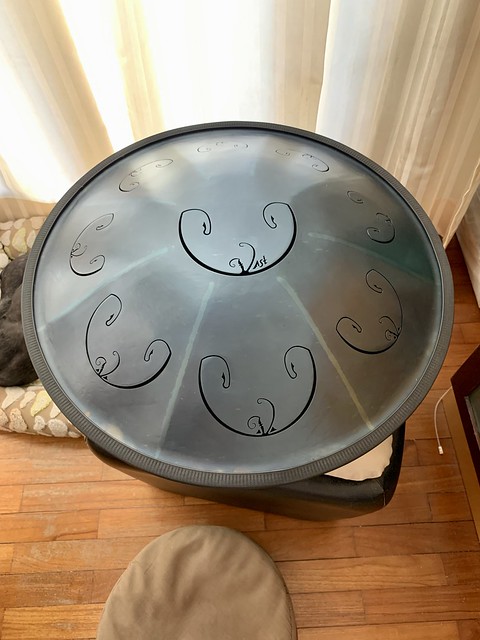I've been mostly a wind instrument player from young, except for an interlude learning the classical guitar, and percussive stuff never caught my interest possibly due to my affinity towards more melodious music. Thanks to Youtube I was introduced to the handpan some years ago and loved its unique soundscape. Unfortunately the availability and price point was a bit high for me.
The Covid pandemic provided a window of opportunity for me to dive deeper into music and one aspect which challenges me is groove. I guess it's partly due to my more dominant left brain which influences how I feel and express music - vanilla playing I'd say. My music teacher once commented I'm weak with phrasing.
This all made sense after reading a highly recommended text, The Music Lesson: A Spiritual Search For Growth Through Music, by Victor L Wooten. I knew it was time to venture further.
So why pick the handpan? Its timbre is unique and captivating as it was created based on the Caribbean steel drum, which has a bright and I'd say shiny sound to it. Watching a player wave his hands about in a blur is almost magical. It's also an instrument that can be free of theory since the notes are limited to a specific scale where any note combination will usually sound nice, and thus easy to improvise on. Essentially the rhythms or groove patterns carry the music. And there's little to study about grooves other than to practise and embody it.
Still, I went ahead and signed up for an online course just to get some structured learning. One can possibly learn from lots of free and good quality online material but it can get messy not knowing how far one has progressed. The additional advantage of the course I'm in is that there's an active online community of students and professionals built around it.
Timing was perfect as I had earlier stumbled across a local shop that sells a China made version. That eliminated the risk of online buying and shipping worries given how expensive and heavy a handpan is. Despite all the online criticism about cheap handpans, I'd say this version is good enough to get someone started. It sounds good, pitch is accurate, and plays well. This one is made of stainless steel and comes in a nice reflective copper colour.
 The early obstacles in handpan playing are mainly about accurate and swift hand movements, followed by balancing of agility and strength between both hands and the fingers used in striking. However compared to instruments such as the Xiao and Shakuhachi, it takes less time to get a consistent good sound. It's easier to start making music albeit at a slow tempo. The challenge for me is more about getting into a relaxed mind-body state and not fumbling on the groove patterns.
The early obstacles in handpan playing are mainly about accurate and swift hand movements, followed by balancing of agility and strength between both hands and the fingers used in striking. However compared to instruments such as the Xiao and Shakuhachi, it takes less time to get a consistent good sound. It's easier to start making music albeit at a slow tempo. The challenge for me is more about getting into a relaxed mind-body state and not fumbling on the groove patterns.
In the world of handpans, there are many makers with their own designs but essentially the tones are produced through the vibration of the metal when struck, similar to how a bell works. Different tone fields (those dimple shapes) are either hammered or hydro-formed by water pressure. Even though made of steel (usually stainless or nitrided) they are susceptible to going out of tune if played too harshly for prolonged periods. This brings me to the next type of pan, which falls into a category called tongue pan.
Tongue pans are similar to tongue drums. Drums are smaller than pans which are typically 20 inch or more in diameter. Mallets are often used to play the drums. Regardless of size, notes are produced by the vibration of the "tongues" (cut outs) of metal. The advantage is that the tuning remains stable because the pitch is determined by the mass of the tongue rather than the tension or shape of the metal.
Among tongue pans, the Rav Vast stands out as it evolved out of the maker's desire for an affordable alternative to the expensive Hang (the very first brand of handpan) that was limited in production. I've done a mini comparison between the Hluru stainless steel handpan and the Rav Vast 2 (thicker version with 2mm steel).
| Attribute | Handpan | Rav Vast |
|---|---|---|
| Dynamics | Loudest note at 89 dBA | Loudest note at 89 dBA |
| Attack and decay | More percussive | Gentle, smooth rise and fall |
| Sustain | Some sustain that's around 10 sec | Much longer sustain at more than 20 sec, reverb feel |
| Tactile feel | Light touch brings up sound. Conversely can't hit too hard as the tone quality becomes rough | Requires more force and can take harder hits without degradation of tone quality |
| Harmonics | Have to explore and figure out specific spots to press and strike to activate harmonics | Each tongue has standardised spots to press and strike for activating harmonics |



